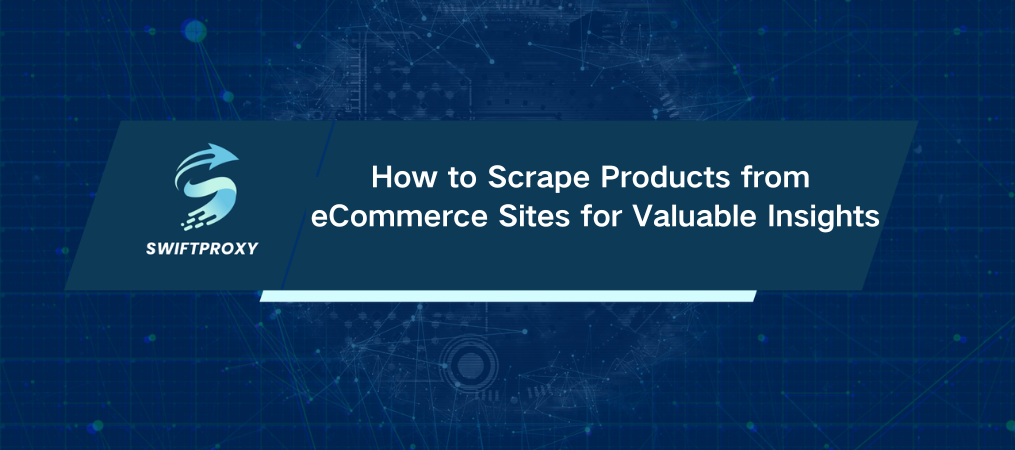How to Scrape Products from eCommerce Sites for Valuable Insights

With over 2.14 billion online shoppers globally, the opportunity to tap into eCommerce data has never been greater. Scraping products from these sites is not just about collecting numbers; it's about gaining valuable insights that can drive your business forward. To truly unlock the potential of this data, following the right steps can elevate your scraping skills from basic to advanced.
Mastering the Steps to Scrape Products from eCommerce Websites
Scraping product data isn't just a technical task—it's an art form that requires strategy, precision, and the right tools. Here's how to do it:
1. Find Your Target eCommerce Site
First, pinpoint the sites that match your business needs. Don't just pick randomly—study the layout and structure. Some sites are simpler to scrape, while others require a more nuanced approach. The better you understand the site, the smoother the process will be.
2. Create Strategy for Scraping
Identify exactly what data you need—product names, prices, descriptions, reviews, availability—and be specific about your requirements. Plan how to navigate the site, address challenges such as pagination, and overcome obstacles like CAPTCHAs or login barriers. It's also important to track how often the site updates, as this will help you avoid outdated information and stay ahead of the competition.
3. Put Your Scraping Process into Action
Now it's time to roll up your sleeves. Whether you're coding custom scripts or using tools like Beautiful Soup, Scrapy, Selenium, or Puppeteer, make sure to monitor your process closely. Scraping isn't a "set it and forget it" task. Constant fine-tuning will keep everything running smoothly.
4. Overcome Common Obstacles
Dynamic content can throw you for a loop, and CAPTCHAs are the ultimate roadblock. But don't worry—browser automation tools like Selenium or Puppeteer are your best friends here. Use them to simulate user interactions, solve CAPTCHAs, and automate login processes. It's all about staying ahead of the game.
Tools and Technologies for Seamless Scraping
Picking the right tool for your scraping job is crucial. It's not just about scraping data; it's about scraping efficiently. Let's break it down:
Beautiful Soup: For beginners or simpler static websites. It's easy to use and quick for parsing HTML/XML data.
Scrapy: Need more power? Scrapy is an open-source Python framework that's built for speed. It can handle complex sites and follow links automatically.
Selenium: More than a testing tool—Selenium is perfect for scraping dynamic, JavaScript-heavy websites. Automate interactions and grab the data you need.
Puppeteer: If you're scraping modern JavaScript-rendered sites, Puppeteer is your go-to. It controls Chrome or Chromium, simulating user behavior seamlessly.
For simpler tasks, Beautiful Soup or Scrapy might be enough. But for complex, dynamic sites, you'll need Selenium or Puppeteer to take full advantage.
Overcoming Web Scraping Challenges
The challenges of web scraping are real, but don't let them derail your plans. Here's how to tackle the most common ones:
1. Dynamic Content
Many modern websites load content dynamically with JavaScript. Traditional scraping methods might not cut it. But tools like Selenium and Puppeteer can simulate real user interactions—clicking buttons, filling out forms, and even scrolling. This lets you scrape content that's rendered on the fly.
2. CAPTCHAs & Login Walls
Sites often use CAPTCHAs or login barriers to block bots. You could use CAPTCHA-solving services, or automate the login process with tools like Selenium. But always keep this in mind: bypassing security measures may violate a site's terms of service. Be sure to review their policies and proceed responsibly.
Final Thoughts
Scraping products from eCommerce sites is an essential practice for gathering data that can drive smarter business decisions. By employing a clear strategy and leveraging the right tools, you can gain a competitive advantage. With the rapid evolution of eCommerce, scraping provides valuable insights that can help keep your business ahead. Start utilizing web scraping today to inform data-driven decisions and propel your business forward.

















































